Thermodynamic and Economic Performance Assessment of Double-Effect Absorption Chiller Systems with Series and Parallel Connections
Abstract
1. Introduction
2. Energy Flows and Thermodynamic Models of Absorption Chillers
2.1. Energy Flowchart of Absorption Chillers
2.2. Thermodynamic Models and Their Validation
3. Evaluation Criteria
3.1. Heat-Transfer Area
3.2. Energy
3.3. Exergy
3.4. Economy
4. Results
4.1. Main Results
4.2. Effect of External Parameters
4.2.1. Impact of Cooling Water Temperature (T23, T25)
- (1)
- Heat-transfer area
- (2)
- COP
- (3)
- Exergy efficiency
- (4)
- Annual cost
4.2.2. Impact of Inlet Chilled Water Temperature (T27)
- (1)
- Heat-transfer area
- (2)
- COP
- (3)
- Exergy efficiency
- (4)
- Annual cost
4.2.3. Effect of Solution Allocation Ratio
5. Conclusions
- The parallel-connected chiller type shows a better energy and exergy performance than a series-connected one when the inlet water temperature is at 12 °C, due to its special structure and higher heat-transfer area: the COP and exergy efficiency are 1.30 and 24.42%, respectively. However, the annual cost of the parallel type is 19% higher than that of the series one.
- The heat-transfer area of the parallel chiller is 228.64 m2 and 237.59 m2 for the series one, respectively. The evaporator, absorber, and condenser of the chiller account for most of the total heat-transfer area: 83.41% in the series type and 86.91%in the parallel one.
- The exergy destruction ratios of the components for the series chiller in descending order were the absorber, LG, HTX, HG, evaporator, condenser and LTX; for the parallel type, the order of the first four components was the LG, absorber, HG, and HTX.
- The sensitivity analysis against the key parameters showed the following:
- For both the series and parallel connected chillers, an increase in the inlet steam temperature decreases the annual total cost due to smaller heat-transfer area required, and improved energy performance. Because of the higher energy level when increasing the inlet steam temperature, the exergy efficiency first rises to a maximum value, and then decreases slightly.
- Increasing the inlet cooling water temperature decreases the energy and exergy performance of the chillers and increases the needed heat-transfer area and annual total cost, because it is more difficult to release the heat in the absorber and condenser.
- Increasing the chilled water temperature positively influences the energy, heat transfer, and economic performance, but reduces the exergy performance due to a decreasing energy level.
- The solution allocation ratio significantly influences the performance of the parallel chiller: as the ratio increases from 0.25 to 1.0, the heat-transfer area and annual total cost decrease by 25.20% and 53.21%, respectively. The energy and exergy performances increase when the allocation ratio rises from 0.25 to 0.54 (maximum value), but then drops almost linearly.
Author Contributions
Funding
Institutional Review Board Statement
Informed Consent Statement
Data Availability Statement
Acknowledgments
Conflicts of Interest
Nomenclature
| AC | Absorption chiller. |
| COP | Coefficient of performance. |
| EES | Engineering Equation Solver. |
| HG | High-pressure generator. |
| HTX | High-temperature heat exchanger. |
| LG | Low-pressure generator. |
| LTX | Low-temperature heat exchanger. |
| Symbols | |
| A | Area, m2. |
| ACC | Annual construction cost, USD. |
| AOC | Annual operation cost, USD. |
| ATC | Annual total cost, USD. |
| CHW/CCW | Unit cost of heating/cooling water, USD/t. |
| CRF | Capital recovery factor. |
| CW | Cooling water consumption, t. |
| D | Solution allocation ratio. |
| Ex | Exergy, Kw. |
| f | Area conversion factor. |
| h | Enthalpy, kJ/kg K. |
| HW | Heating water consumption, t. |
| j | Interest rate. |
| HTA | Heat-transfer area, m2. |
| m | Mass flow, kg/s. |
| n | Service life, years. |
| Q | Thermal energy, kW. |
| T | Temperature, °C. |
| U | Heat-transfer coefficient, kW/(m2 K). |
| Z | Initial investment cost, USD. |
| w | Concentration of LiBr. |
| ζ | Logarithmic mean temperature difference. |
| η | Efficiency. |
| Subscript | |
| i | ith component. |
| in/out | Inlet/outlet. |
| eva | Evaporator. |
| loss | Loss. |
Appendix A
| Series-Connected Chiller | Parallel-Connected Chiller | |||||
|---|---|---|---|---|---|---|
| State | Pressure, kPa | Concentration, % | Mass Flow Rate, kg/s | Pressure, kPa | Concentration, % | Mass Flow Rate, kg/s |
| 1 | 0.803 | 53.087 | 1.099 | 0.924 | 51.792 | 1.212 |
| 2 | 4.145 | 53.087 | 1.099 | 4.145 | 51.792 | 1.212 |
| 3 | 4.145 | 53.087 | 1.099 | 4.145 | 51.792 | 1.212 |
| 4 | 4.145 | 62.657 | 0.931 | 4.145 | 60.102 | 1.044 |
| 5 | 4.145 | 62.657 | 0.931 | 4.145 | 60.102 | 1.044 |
| 6 | 0.803 | 62.657 | 0.931 | 0.924 | 60.102 | 1.044 |
| 7 | 4.145 | 0 | 0.085 | 4.145 | 0 | 0.078 |
| 8 | 4.145 | 0 | 0.168 | 4.145 | 0 | 0.168 |
| 9 | 0.803 | 0 | 0.168 | 0.924 | 0 | 0.168 |
| 10 | 0.803 | 0 | 0.168 | 0.924 | 0 | 0.168 |
| 11 | - | - | - | 4.145 | 51.792 | 0.652 |
| 12 | - | - | - | 72.257 | 51.792 | 0.652 |
| 13 | 88.904 | 53.087 | 1.099 | 72.257 | 51.792 | 0.652 |
| 14 | 88.904 | 57.421 | 1.016 | 72.257 | 60.102 | 0.561 |
| 15 | 88.904 | 57.421 | 1.016 | 72.257 | 60.102 | 0.561 |
| 16 | 4.145 | 57.421 | 1.016 | 4.145 | 60.102 | 0.561 |
| 17 | 88.904 | 0 | 0.083 | 72.257 | 0 | 0.090 |
| 18 | 88.904 | 0 | 0.083 | 72.257 | 0 | 0.090 |
| 19 | 4.145 | 0 | 0.083 | 4.145 | 0 | 0.090 |
| 20 | - | - | - | 4.145 | 51.792 | 0.560 |
References
- She, X.; Cong, L.; Nie, B.; Leng, G.; Peng, H.; Chen, Y.; Zhang, X.; Wen, T.; Yang, H.; Luo, Y. Energy-efficient and -economic technologies for air conditioning with vapor compression refrigeration: A comprehensive review. Appl. Energy 2018, 232, 157–186. [Google Scholar] [CrossRef]
- Pang, S.C.; Masjuki, H.H.; Kalam, M.A.; Hazrat, M.A. Liquid absorption and solid adsorption system for household, industrial and automobile applications: A review. Renew. Sustain. Energy Rev. 2013, 28, 836–847. [Google Scholar] [CrossRef]
- Khosravi, N.; Aydin, D.; Karim Nejhad, M.; Dogramaci, P.A. Comparative performance analysis of direct and desiccant assisted evaporative cooling systems using novel candidate materials. Energy Convers. Manag. 2020, 221, 113167. [Google Scholar] [CrossRef]
- Huang, Y.; Jiang, P.; Zhu, Y. Experimental and modeling studies of thermally-driven subcritical and transcritical ejector refrigeration systems. Energy Convers. Manag. 2020, 224, 113361. [Google Scholar] [CrossRef]
- Arabkoohsar, A.; Sadi, M. Technical comparison of different solar-powered absorption chiller designs for co-supply of heat and cold networks. Energy Convers. Manag. 2020, 206, 112343. [Google Scholar] [CrossRef]
- Almohammadi, K.M.; Harby, K. Operational conditions optimization of a proposed solar-powered adsorption cooling system: Experimental, modeling, and optimization algorithm techniques. Energy 2020, 206, 118007. [Google Scholar] [CrossRef]
- Mujahid Rafique, M.; Gandhidasan, P.; Rehman, S.; Al-Hadhrami, L.M. A review on desiccant based evaporative cooling systems. Renew. Sustain. Energy Rev. 2015, 45, 145–159. [Google Scholar] [CrossRef]
- Tashtoush, B.; Algharbawi, A.B.R. Parametric study of a Novel Hybrid Solar Variable Geometry Ejector cooling with Organic Rankine Cycles. Energy Convers. Manag. 2019, 198, 111910. [Google Scholar] [CrossRef]
- Li, X.H.; Hou, X.H.; Zhang, X.; Yuan, Z.X. A review on development of adsorption cooling—Novel beds and advanced cycles. Energy Convers. Manag. 2015, 94, 221–232. [Google Scholar] [CrossRef]
- Gediz Ilis, G.; Demir, H.; Mobedi, M.; Baran Saha, B. A new adsorbent bed design: Optimization of geometric parameters and metal additive for the performance improvement. Appl. Therm. Eng. 2019, 162, 114270. [Google Scholar] [CrossRef]
- Amin, M.; Chetpattananondh, P.; Khan, M.N. Ultrasound assisted adsorption of reactive dye-145 by biochars from marine Chlorella sp. extracted solid waste pyrolyzed at various temperatures. J. Environ. Chem. Eng. 2020, 6, 104403. [Google Scholar] [CrossRef]
- Lu, Z. Operation performance study and numerical analysis of the multi-objective adsorption system driven by low-grade heat of solar energy and industrial waste heat. Sol. Energy 2020, 199, 575–584. [Google Scholar] [CrossRef]
- Shirazi, A.; Taylor, R.A.; Morrison, G.L.; White, S.D. Solar-powered absorption chillers: A comprehensive and critical review. Energy Convers. Manag. 2018, 171, 59–81. [Google Scholar] [CrossRef]
- Arshi Banu, P.S.; Sudharsan, N.M. Review of water based vapour absorption cooling systems using thermodynamic analysis. Renew. Sustain. Energy Rev. 2018, 82, 3750–3761. [Google Scholar] [CrossRef]
- Narváez-Romo, B.; Chhay, M.; Zavaleta-Aguilar, E.W.; Simões-Moreira, J.R. A critical review of heat and mass transfer correlations for LiBr-H2O and NH3-H2O absorption refrigeration machines using falling liquid film technology. Appl. Therm. Eng. 2017, 123, 1079–1095. [Google Scholar] [CrossRef]
- Shankar, R.; Rivera, W. Investigation of new cooling cogeneration cycle using NH3H2O mixture. Int. J. Refrig. 2020, 114, 88–97. [Google Scholar] [CrossRef]
- Chen, Y.; Wang, J.; Lund, P.D. Thermodynamic performance analysis and multi-criteria optimization of a hybrid combined heat and power system coupled with geothermal energy. Energy Convers. Manag. 2020, 210, 112741. [Google Scholar] [CrossRef]
- Gomri, R. Simulation study on the performance of solar/natural gas absorption cooling chillers. Energy Convers. Manag. 2013, 65, 675–681. [Google Scholar] [CrossRef]
- Fan, Y.; Luo, L.; Souyri, B. Review of solar sorption refrigeration technologies: Development and applications. Renew. Sustain. Energy Rev. 2007, 11, 1758–1775. [Google Scholar] [CrossRef]
- Shu, G.; Che, J.; Tian, H.; Wang, X.; Liu, P. A compressor-assisted triple-effect H2O-LiBr absorption cooling cycle coupled with a Rankine Cycle driven by high-temperature waste heat. Appl. Therm. Eng. 2017, 112, 1626–1637. [Google Scholar] [CrossRef]
- Mohammadi, K.; Jiang, Y.; Borjian, S.; Powell, K. Thermo-economic assessment and optimization of a hybrid triple effect absorption chiller and compressor. Sustain. Energy Technol. Assess. 2020, 38, 100652. [Google Scholar] [CrossRef]
- Chen, J.F.; Dai, Y.J.; Wang, R.Z. Experimental and analytical study on an air-cooled single effect LiBr-H2O absorption chiller driven by evacuated glass tube solar collector for cooling application in residential buildings. Sol. Energy 2017, 151, 110–118. [Google Scholar] [CrossRef]
- Zheng, X.; Shi, R.; Wang, Y.; You, S.; Zhang, H.; Xia, J.; Wei, S. Mathematical modeling and performance analysis of an integrated solar heating and cooling system driven by parabolic trough collector and double-effect absorption chiller. Energy Build. 2019, 202, 109400. [Google Scholar] [CrossRef]
- Ehyaei, M.A.; Ahmadi, A.; El Haj Assad, M.; Rosen, M.A. Investigation of an integrated system combining an Organic Rankine Cycle and absorption chiller driven by geothermal energy: Energy, exergy, and economic analyses and optimization. J. Clean. Prod. 2020, 258, 120780. [Google Scholar] [CrossRef]
- Avanessian, T.; Ameri, M. Energy, exergy, and economic analysis of single and double effect LiBr–H2O absorption chillers. Energy Build. 2014, 73, 26–36. [Google Scholar] [CrossRef]
- Talukdar, K.; Gogoi, T.K. Exergy analysis of a combined vapor power cycle and boiler flue gas driven double effect water–LiBr absorption refrigeration system. Energy Convers. Manag. 2016, 108, 468–477. [Google Scholar] [CrossRef]
- Yin, H.; Qu, M.; Archer, D.H. Model based experimental performance analysis of a microscale LiBr–H2O steam-driven double-effect absorption Chiller. Appl. Therm. Eng. 2010, 30, 1741–1750. [Google Scholar] [CrossRef]
- Alhamid, M.I.; Coronas, A.; Lubis, A.; Ayou, D.S.; Nasruddin; Saito, K.; Yabase, H. Operation strategy of a solar-gas fired single/double effect absorption chiller for space cooling in Indonesia. Appl. Therm. Eng. 2020, 178, 115524. [Google Scholar] [CrossRef]
- Chahartaghi, M.; Golmohammadi, H.; Shojaei, A.F. Performance analysis and optimization of new double effect lithium bromide–water absorption chiller with series and parallel flows. Int. J. Refrig. 2019, 97, 73–87. [Google Scholar] [CrossRef]
- Wang, J.; Chen, Y.; Lior, N. Exergo-economic analysis method and optimization of a novel photovoltaic/thermal solar-assisted hybrid combined cooling, heating and power system. Energy Convers. Manag. 2019, 199, 111945. [Google Scholar] [CrossRef]
- Mussati, S.F.; Gernaey, K.V.; Morosuk, T.; Mussati, M.C. NLP modeling for the optimization of LiBr-H2O absorption refrigeration systems with exergy loss rate, heat transfer area, and cost as single objective functions. Energy Convers. Manag. 2016, 127, 526–544. [Google Scholar] [CrossRef]
- Yu, M.; Chen, Z.; Yao, D.; Zhao, F.; Pan, X.; Liu, X.; Cui, P.; Zhu, Z.; Wang, Y. Energy, exergy, economy analysis and multi-objective optimization of a novel cascade absorption heat transformer driven by low-level waste heat. Energy Convers. Manag. 2020, 221, 113162. [Google Scholar] [CrossRef]
- Fu, C.; Shen, Q.; Wu, T. Exergo-economic comparisons of solar cooling systems coupled to series/parallel absorption chiller types considering the lowest heat transfer area. Case Stud. Therm. Eng. 2022, 39, 102456. [Google Scholar] [CrossRef]
- Mussati, S.F.; Cignitti, S.; Mansouri, S.S.; Gernaey, K.V.; Morosuk, T.; Mussati, M.C. Configuration optimization of series flow double-effect water-lithium bromide absorption refrigeration systems by cost minimization. Energy Convers. Manag. 2018, 158, 359–372. [Google Scholar] [CrossRef]
- Tzivanidis, C.; Bellos, E.; Antonopoulos, K.A. Energetic and financial investigation of a stand-alone solar-thermal Organic Rankine Cycle power plant. Energy Convers. Manag. 2016, 126, 421–433. [Google Scholar] [CrossRef]
- F-Chart. Software, Engineering Equation Solver (EES). Available online: http://www.fchart.com/ees/>2012 (accessed on 1 October 2022).
- Herold, K.E.; Radermacher, R.; Klein, S.A. Absorption Chillers and Heat Pumps, 2nd ed.; CRC Press: Boca Raton, FL, USA, 2016; pp. 157–171. [Google Scholar]
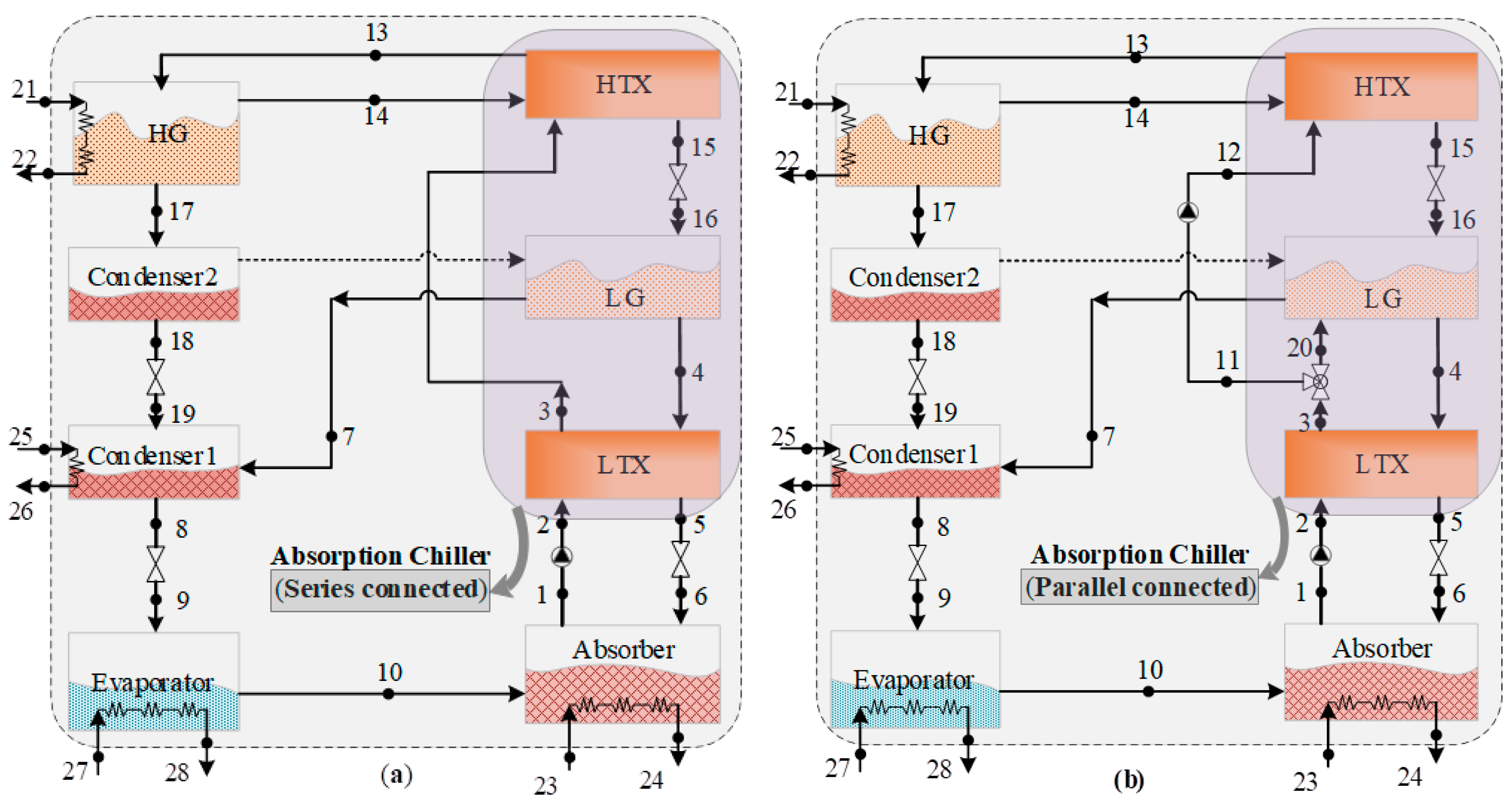
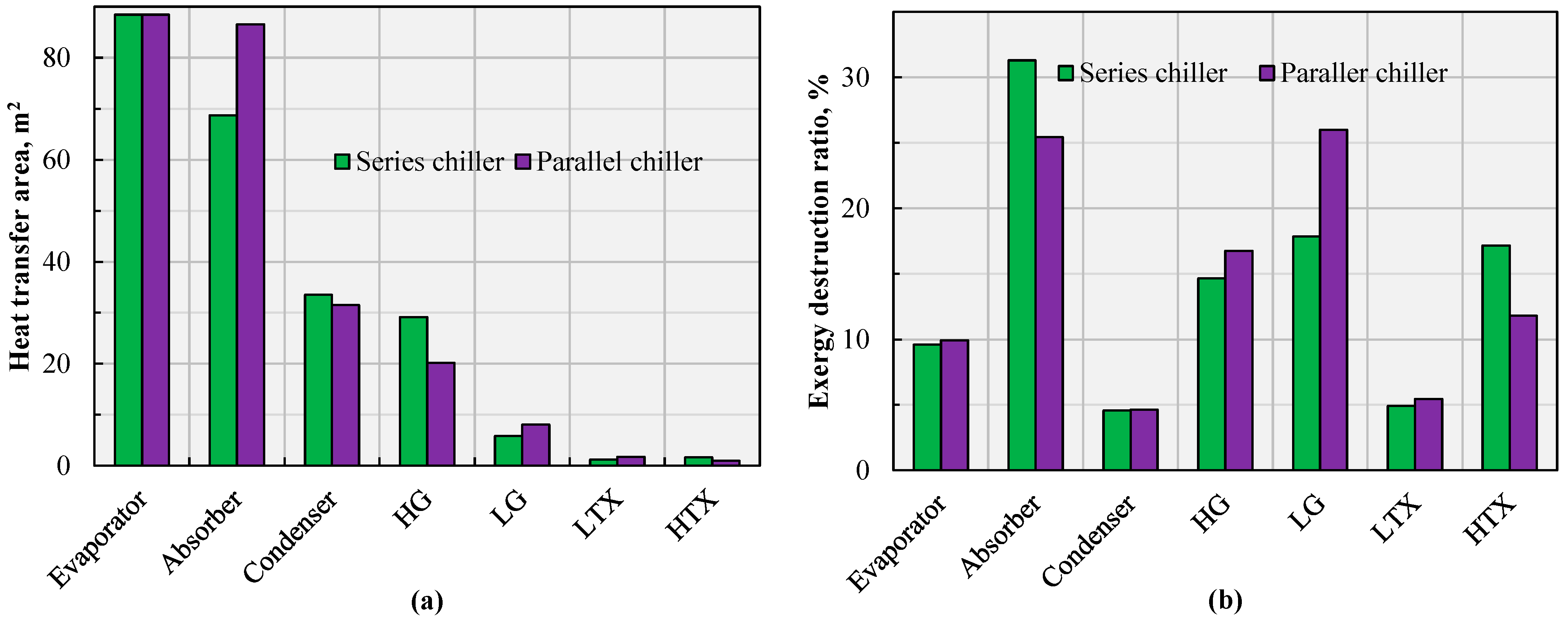
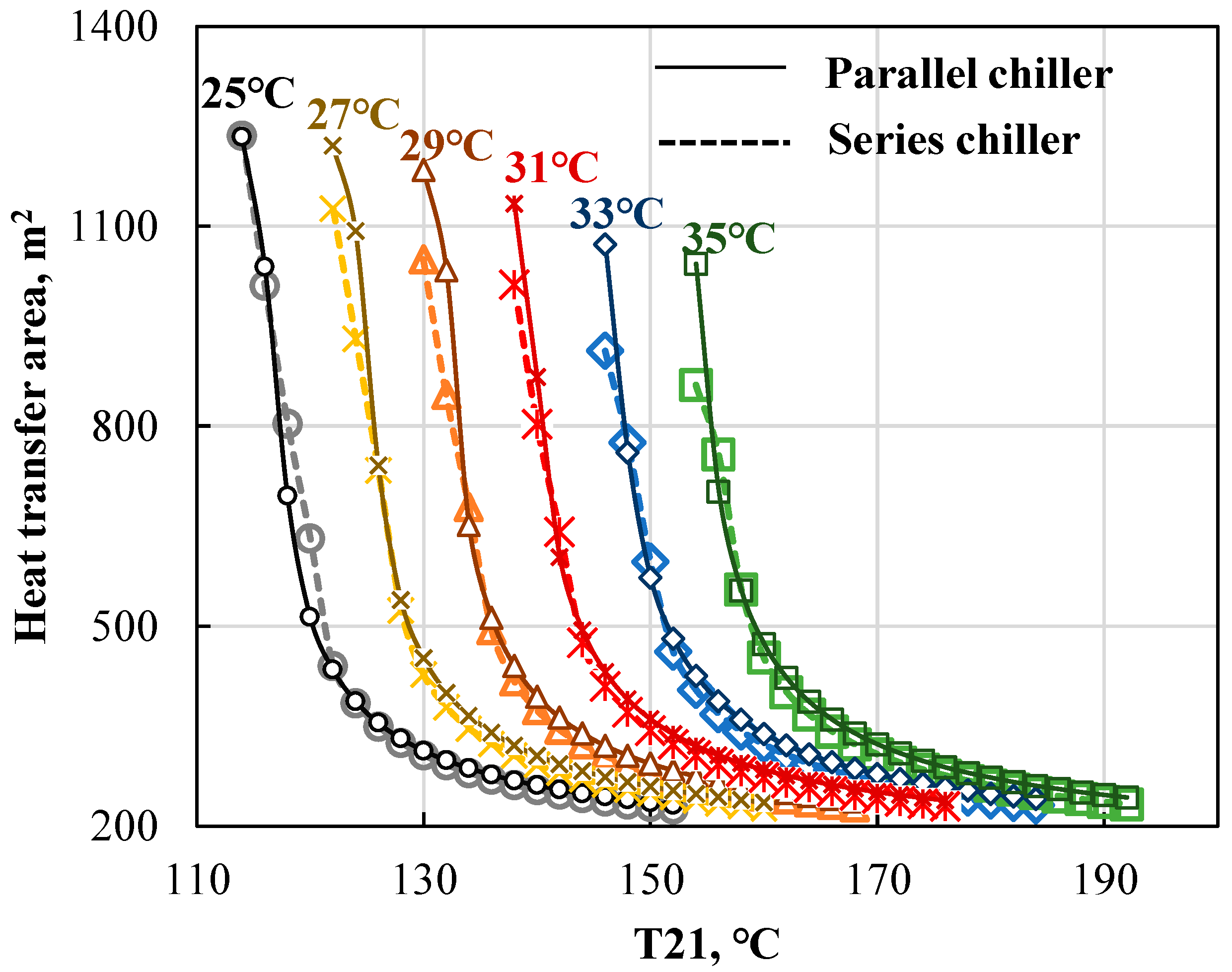
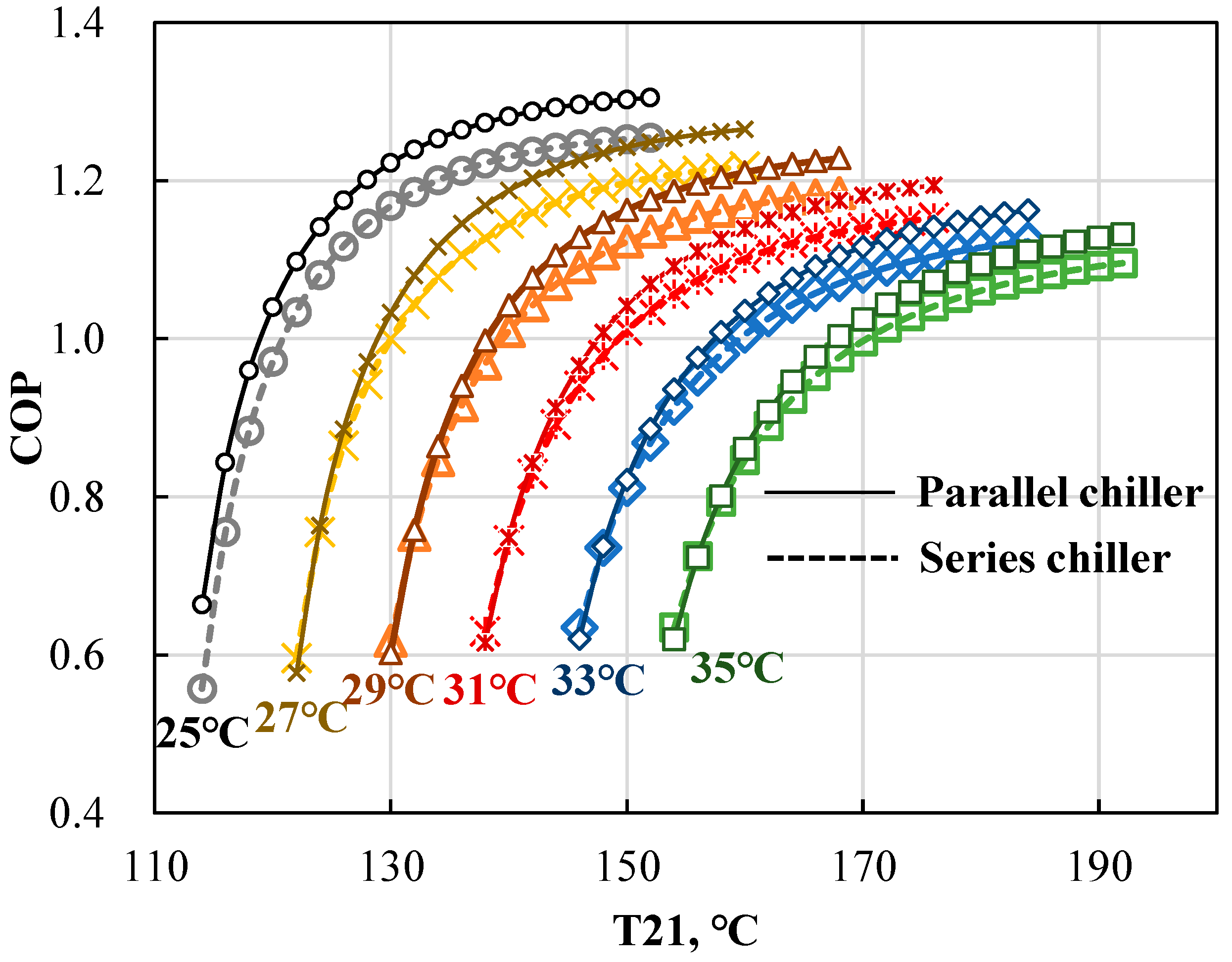
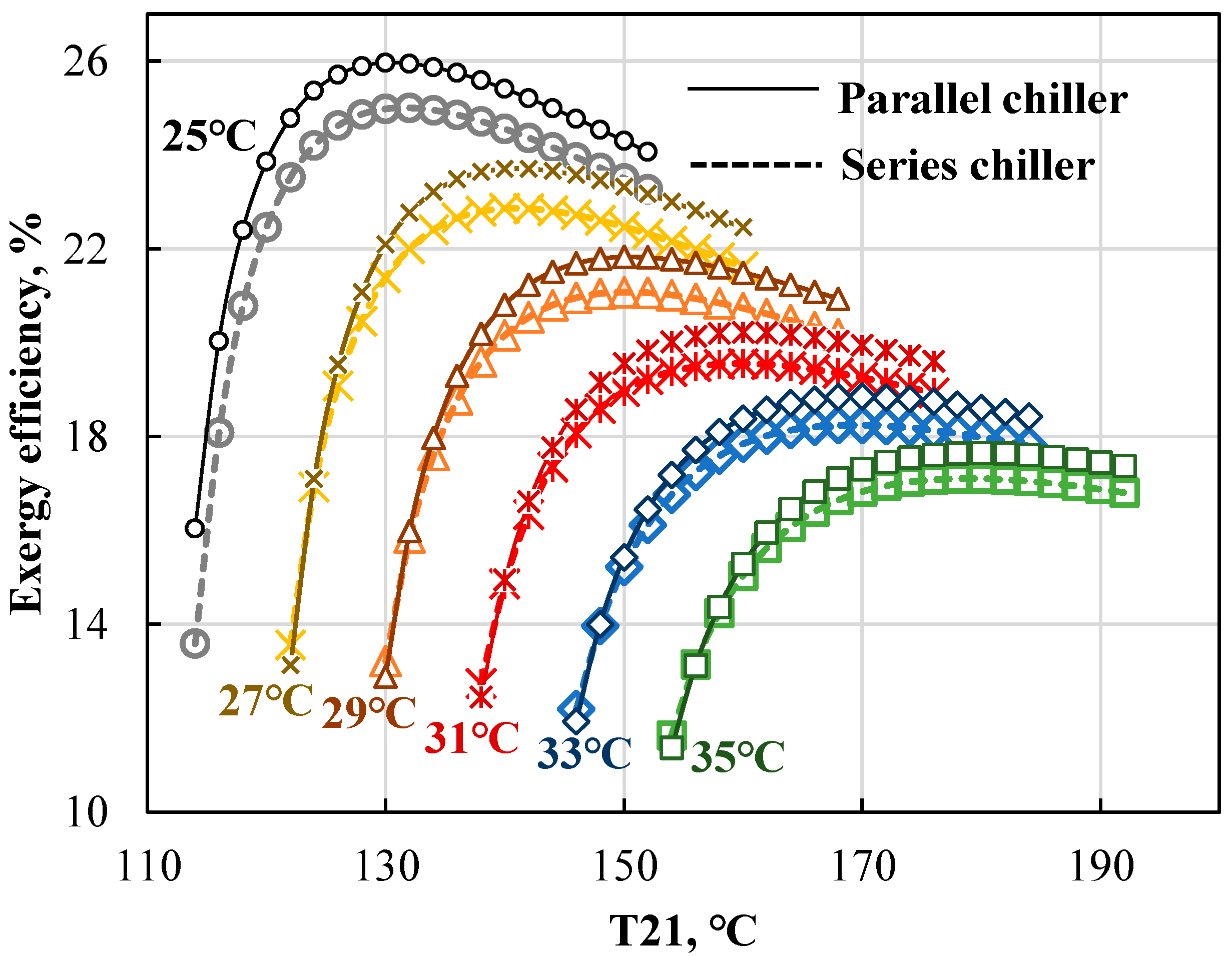
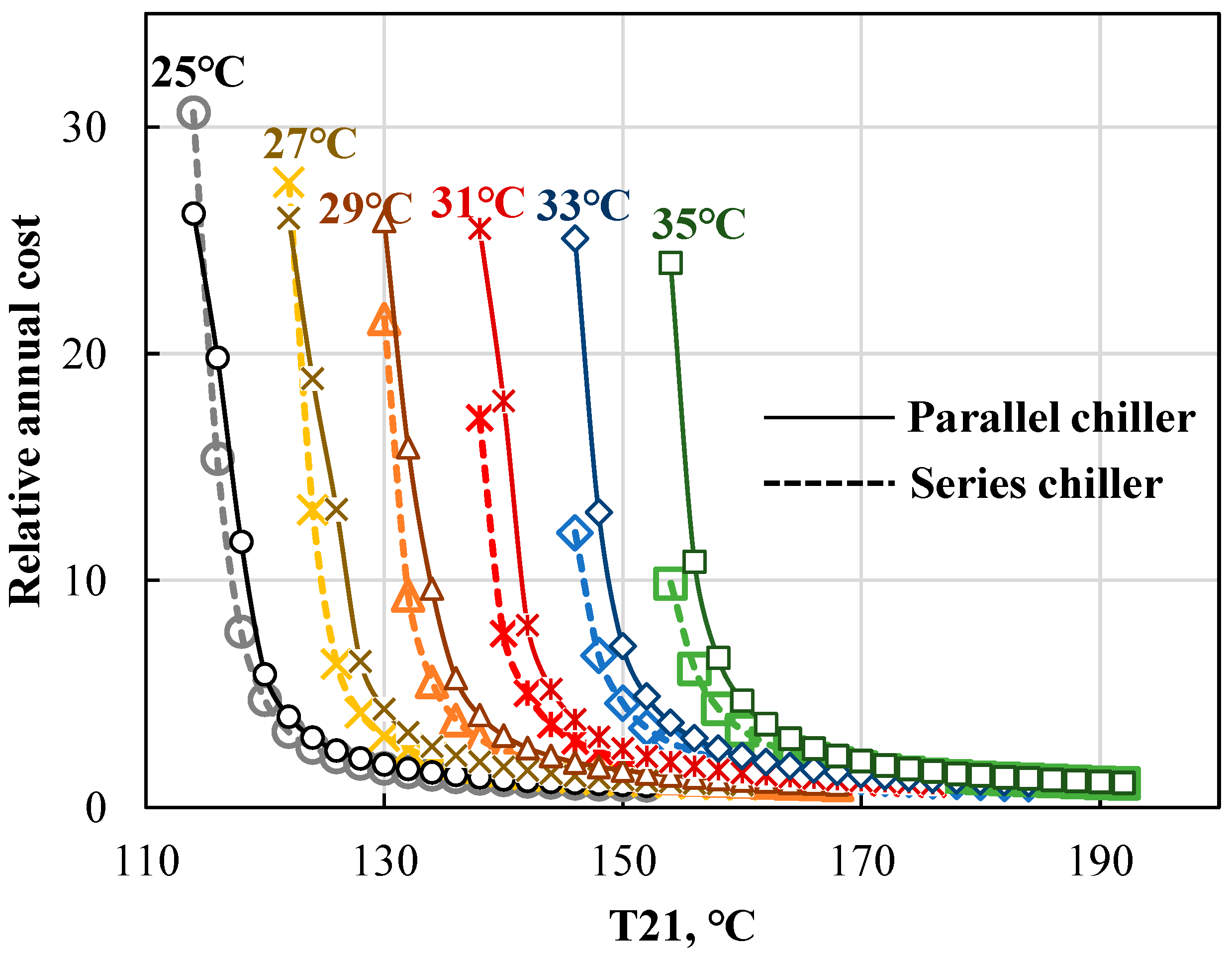
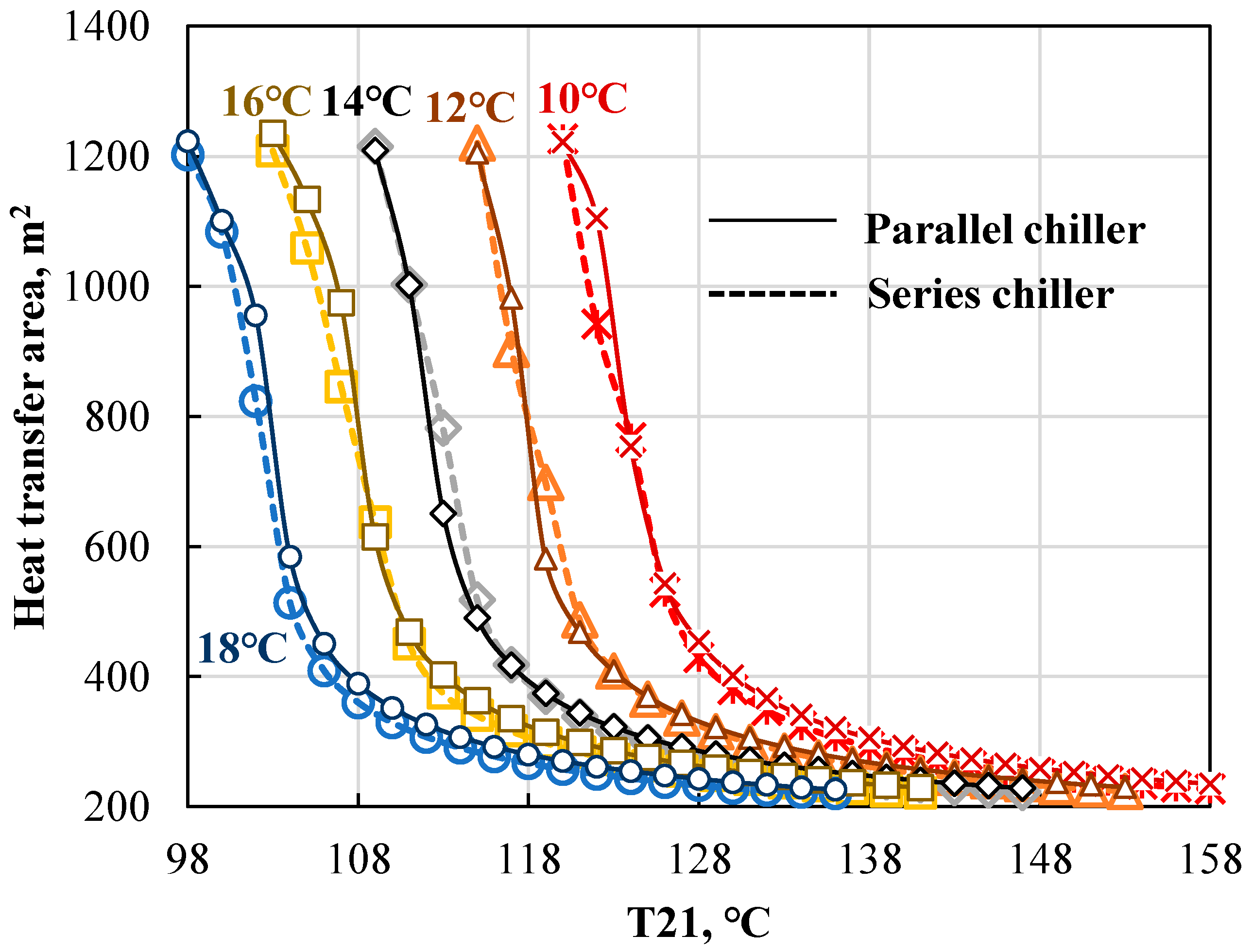
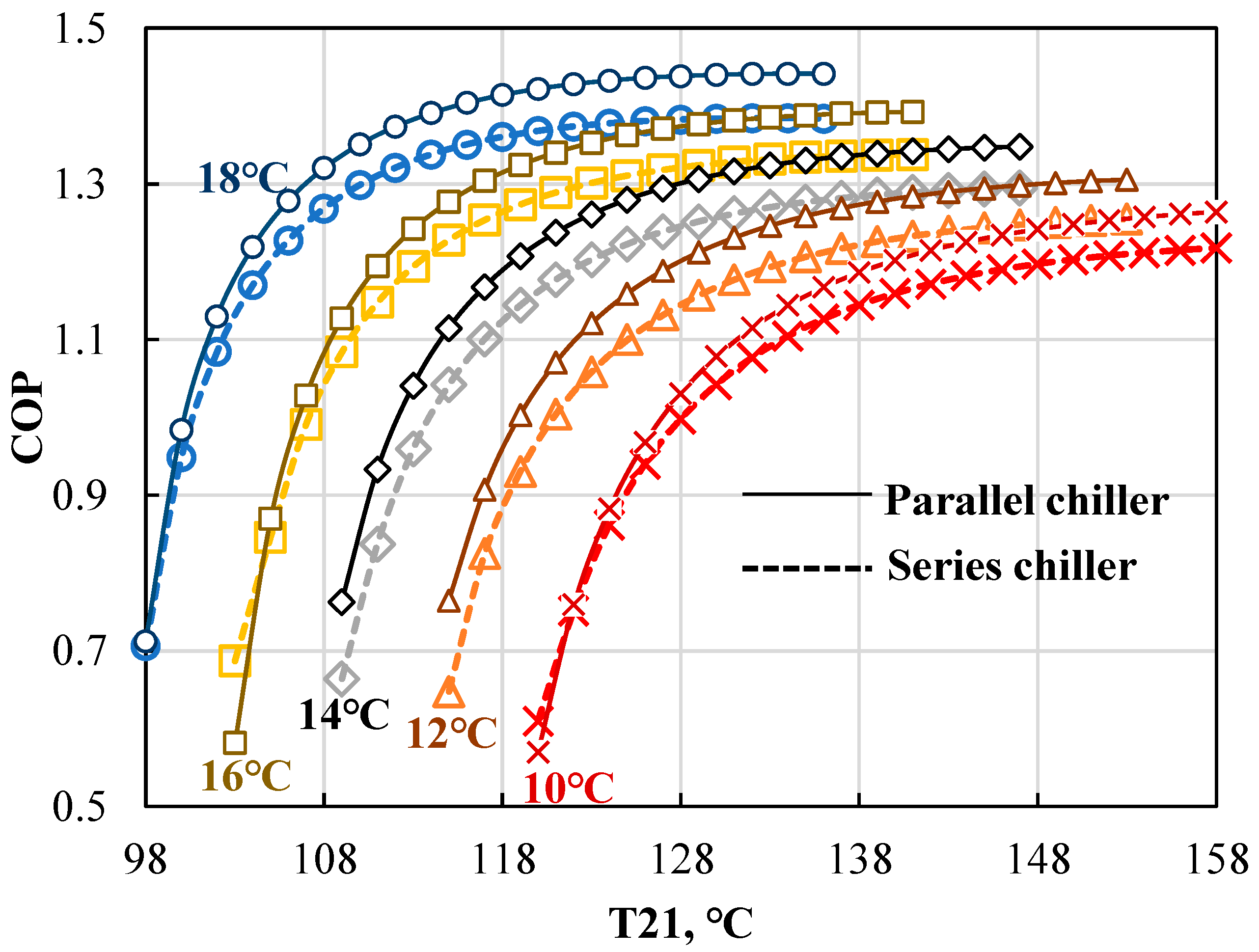
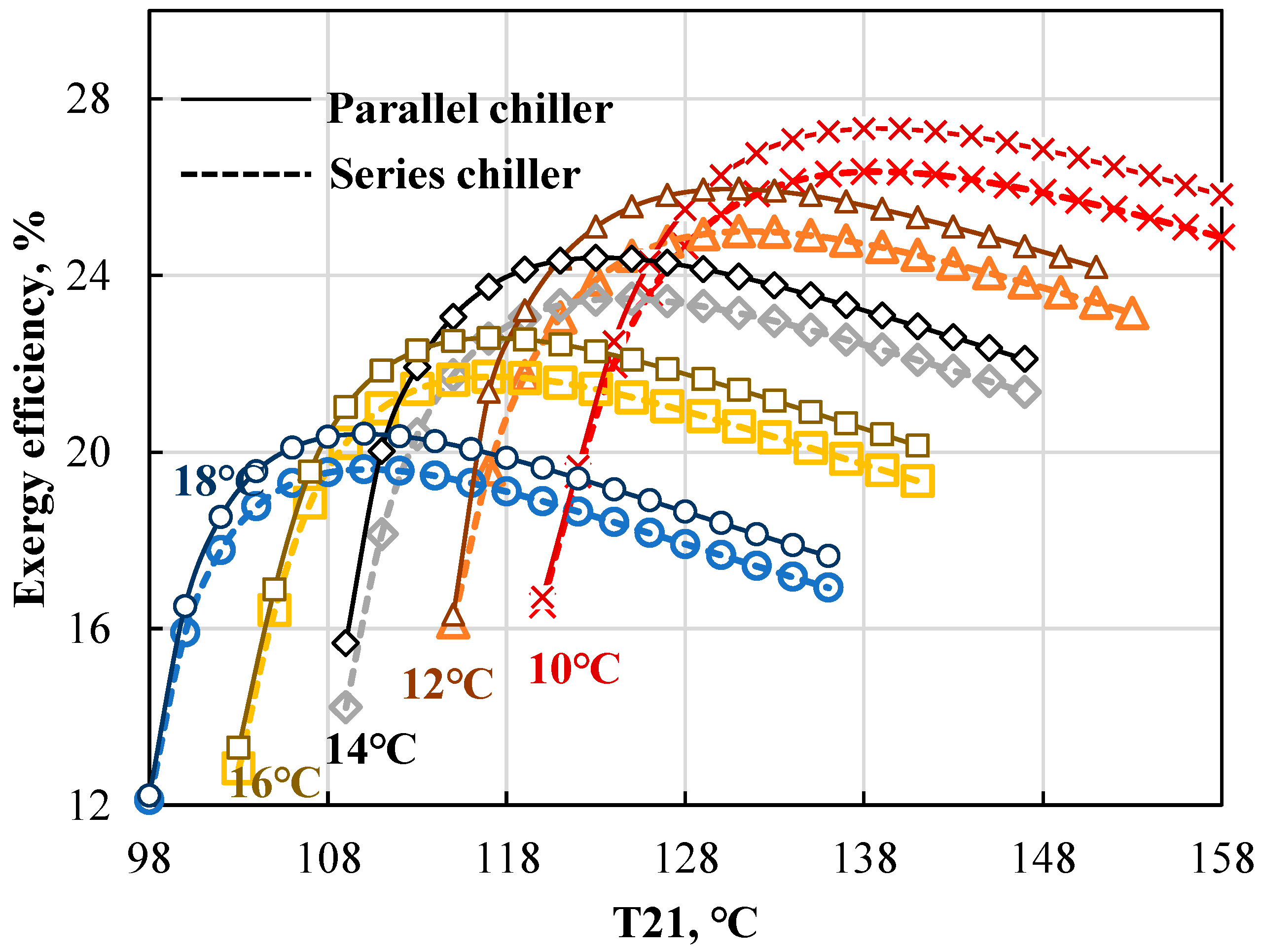
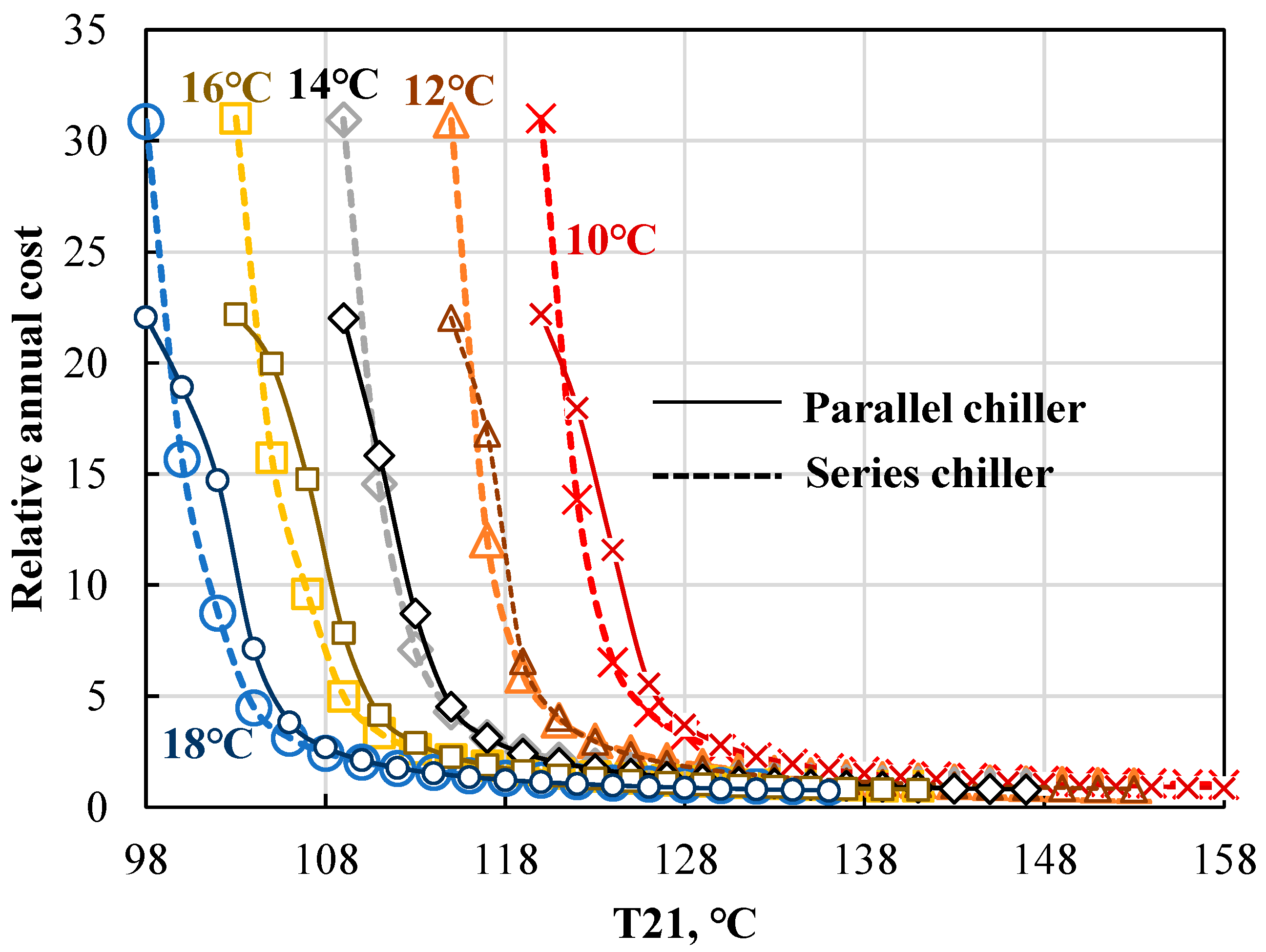
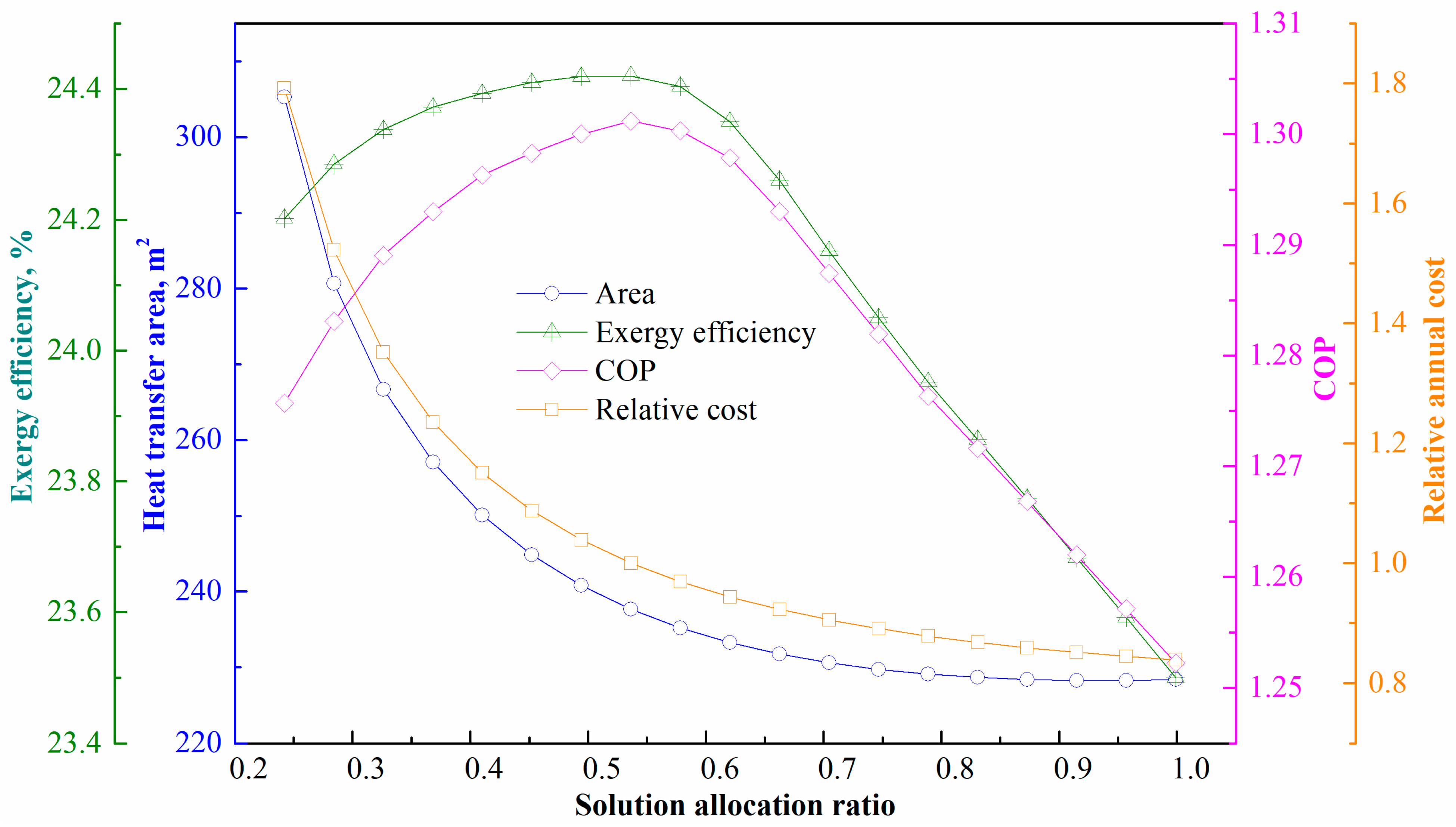
| Item | Series-Connected Chiller | Parallel-Connected Chiller |
|---|---|---|
| HG | ||
| LG | ||
| Condenser 1 | ||
| Evaporator | ||
| Absorber | ||
| LTX | ||
| HTX | ||
| Item | Value | |
|---|---|---|
| U, kW/(m2 K) | HG, LG | 1.5 |
| Absorber | 0.7 | |
| Evaporator | 1.5 | |
| Condenser | 2.5 | |
| LTX, HTX | 1.0 | |
| Heat efficiency | LTX, HTX (,) | 0.5 |
| Component | Initial Investment Cost (Z) | ||
|---|---|---|---|
| HG, LG | Condenser | ||
| Evaporator | LTX, HTX | ||
| Absorber |
| Item | Working Fluid | Value |
|---|---|---|
| Cooling capacity of absorption chiller | 400 kW | |
| Inlet/outlet temperature of steam (T21) | Solar steam | 170/160 °C |
| Inlet/outlet cooling temperature (T23, T25) | Water | 25/34 °C |
| Inlet/outlet temperature of chilled water (T27) | Water | 12/7 °C |
| Reference Study | This Study | Relative Error, % | |
|---|---|---|---|
| LG | 225 | 223 | 0.9 |
| HG | 348 | 344 | 1.1 |
| LTX | 151 | 143 | 5.3 |
| HTX | 146 | 137 | 6.2 |
| Absorber | 603 | 582 | 3.5 |
| Condenser | 432 | 420 | 1.9 |
| Items | Series Connected AC | Parallel Connected AC |
|---|---|---|
| Solution allocation ratio | - | 0.54 |
| Total heat-transfer area | 228.64 m2 | 237.59 m2 |
| COP | 1.25 | 1.30 |
| Exergy efficiency | 23.49% | 24.42% |
| Total annual cost | 455,428$ | 541,939$ |
| Section | Section 4.2.1 | Section 4.2.2 | Section 4.2.3 |
|---|---|---|---|
| Solar steam temperature (T21), °C | 114–192 | 98–158 | 150 |
| Cooling water temperature (T23, T25), °C | 25–35 | 25 | 25 |
| Chilled water temperature (T27), °C | 12 | 10–18 | 12 |
| Solution allocation ratio (D) | 0.54 | 0.54 | 025–1.0 |
Publisher’s Note: MDPI stays neutral with regard to jurisdictional claims in published maps and institutional affiliations. |
© 2022 by the authors. Licensee MDPI, Basel, Switzerland. This article is an open access article distributed under the terms and conditions of the Creative Commons Attribution (CC BY) license (https://creativecommons.org/licenses/by/4.0/).
Share and Cite
Hu, J.; Teng, K.; Qiu, Y.; Chen, Y.; Wang, J.; Lund, P. Thermodynamic and Economic Performance Assessment of Double-Effect Absorption Chiller Systems with Series and Parallel Connections. Energies 2022, 15, 9105. https://doi.org/10.3390/en15239105
Hu J, Teng K, Qiu Y, Chen Y, Wang J, Lund P. Thermodynamic and Economic Performance Assessment of Double-Effect Absorption Chiller Systems with Series and Parallel Connections. Energies. 2022; 15(23):9105. https://doi.org/10.3390/en15239105
Chicago/Turabian StyleHu, Jianke, Kai Teng, Yida Qiu, Yuzhu Chen, Jun Wang, and Peter Lund. 2022. "Thermodynamic and Economic Performance Assessment of Double-Effect Absorption Chiller Systems with Series and Parallel Connections" Energies 15, no. 23: 9105. https://doi.org/10.3390/en15239105
APA StyleHu, J., Teng, K., Qiu, Y., Chen, Y., Wang, J., & Lund, P. (2022). Thermodynamic and Economic Performance Assessment of Double-Effect Absorption Chiller Systems with Series and Parallel Connections. Energies, 15(23), 9105. https://doi.org/10.3390/en15239105







